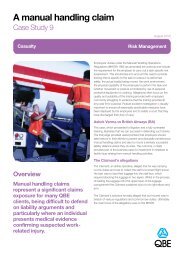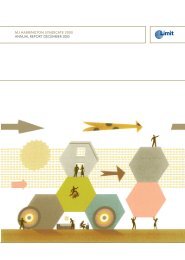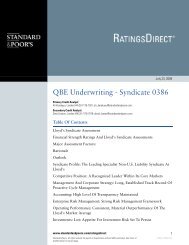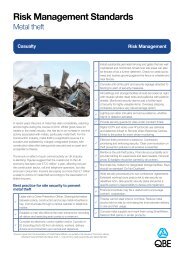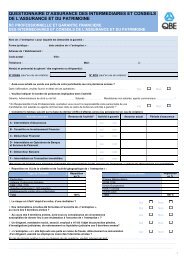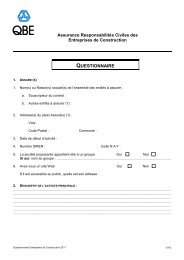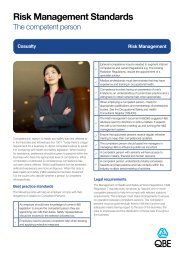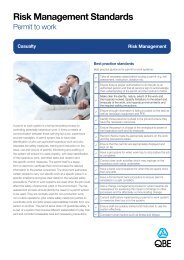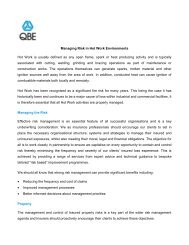QBE Syndicate 2999 Annual Report and Accounts 2009
QBE Syndicate 2999 Annual Report and Accounts 2009
QBE Syndicate 2999 Annual Report and Accounts 2009
You also want an ePaper? Increase the reach of your titles
YUMPU automatically turns print PDFs into web optimized ePapers that Google loves.
1 Accounting policies continued<br />
b) Basis of accounting for insurance continued<br />
iv) Claims provisions <strong>and</strong> related recoveries continued<br />
Case estimates are set by experienced claims technicians, applying their skill <strong>and</strong> specialist knowledge to the circumstances of individual claims. The<br />
ultimate cost of outst<strong>and</strong>ing claims, including claims incurred but not reported, is estimated by the syndicate actuaries who apply recognised actuarial<br />
techniques considered appropriate for each portfolio, such as the Chain Ladder <strong>and</strong> Bornhuetter-Ferguson methods. These methods take into account,<br />
amongst other things, statistical analysis of the development of the value <strong>and</strong> frequency of past claims <strong>and</strong> the results of analyses undertaken at the point<br />
of underwriting. Techniques considered appropriate for specific portfolios include contract by contract analysis, segmentation by subclass, <strong>and</strong> stochastic<br />
analysis. Classes of business are analysed at a level of detail appropriate to their materiality. Allowance is made for changes or uncertainties which may<br />
create distortions in the underlying statistics or which might cause the cost of unsettled claims to increase or decrease when compared with the cost of<br />
previously settled claims, for example, one-off occurrences <strong>and</strong> changes in mix of business, policy conditions or the legal environment.<br />
The syndicate actuaries produce an estimate of reserves, which is reviewed by an independent actuarial firm, <strong>and</strong> is then assessed by <strong>QBE</strong> management<br />
with input from the syndicate underwriting <strong>and</strong> claims experts.<br />
As provisions for claims outst<strong>and</strong>ing are based on information which is currently available, the eventual outcome may vary from the original assessment<br />
depending on the nature of information received or developments in future periods. For certain classes of business including liability <strong>and</strong> other long-tail<br />
classes written by the syndicate, claims may not be apparent for many years after the event giving rise to the claim has happened. These classes will<br />
typically display greater variation between initial estimates <strong>and</strong> final outcomes. Differences between the estimated cost <strong>and</strong> subsequent re-estimation<br />
or settlement of claims are reflected in the technical account for the year in which these claims are re-estimated or settled.<br />
Provisions are calculated gross of any reinsurance recoveries. A separate estimate is made of the amounts that will be recoverable from reinsurers based<br />
upon the gross provisions <strong>and</strong> having due regard to collectability.<br />
v) Unexpired risks provision<br />
Provision is made for any deficiencies arising when unearned premiums, net of associated acquisition costs, are insufficient to meet expected claims<br />
<strong>and</strong> expenses after taking into account future investment return on the investments supporting the unearned premiums provision <strong>and</strong> unexpired risks<br />
provision. The expected claims are calculated having regard to events that have occurred prior to the balance sheet date.<br />
Unexpired risks surpluses <strong>and</strong> deficits are offset where business classes are managed together.<br />
vi) Reinsurance to close (“RITC”)<br />
Following the end of the third year, the underwriting account of each Lloyd’s syndicate is normally closed by reinsurance into the following year of<br />
account. The amount of the RITC premium is determined by the managing agent, generally by estimating the cost of claims notified but not settled<br />
together with the estimated cost of claims incurred but not reported at that date <strong>and</strong> claims h<strong>and</strong>ling costs.<br />
The payment of an RITC premium does not eliminate the liability of the closed year for outst<strong>and</strong>ing claims. If the reinsuring syndicate was unable to meet<br />
its obligations, <strong>and</strong> other elements of Lloyd’s chain of security were to fail, then the closed underwriting account would have to settle the outst<strong>and</strong>ing<br />
claims. The directors consider that the likelihood of such a failure of the RITC is remote, <strong>and</strong> consequently the RITC has been deemed to settle liabilities<br />
outst<strong>and</strong>ing at the closure of an underwriting account.<br />
As the RITC is concluded after the balance sheet date, this is a non-adjusting event under FRS 21, “Events after balance sheet date”, <strong>and</strong> recognised<br />
in the period in which it is concluded.<br />
vii) Acquisition costs<br />
Acquisition costs, which represent commission <strong>and</strong> other costs related to the acquisition of new insurance contracts, are deferred subject to recoverability<br />
<strong>and</strong> amortised over the period to which the related premiums are earned.<br />
29<br />
<strong>QBE</strong> <strong>Syndicate</strong> <strong>2999</strong><br />
<strong>Annual</strong> report <strong>2009</strong>



